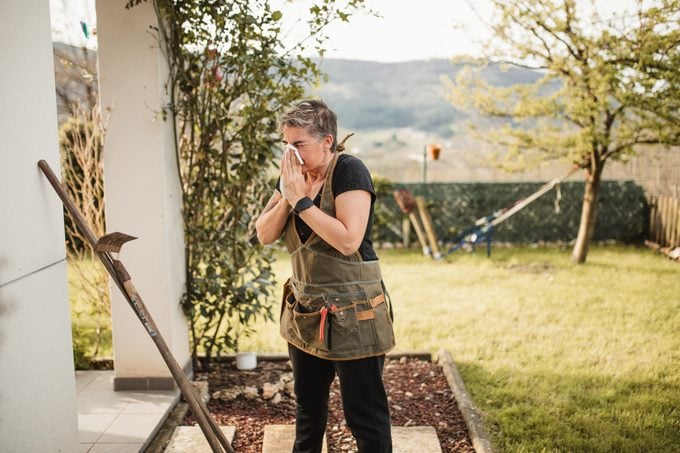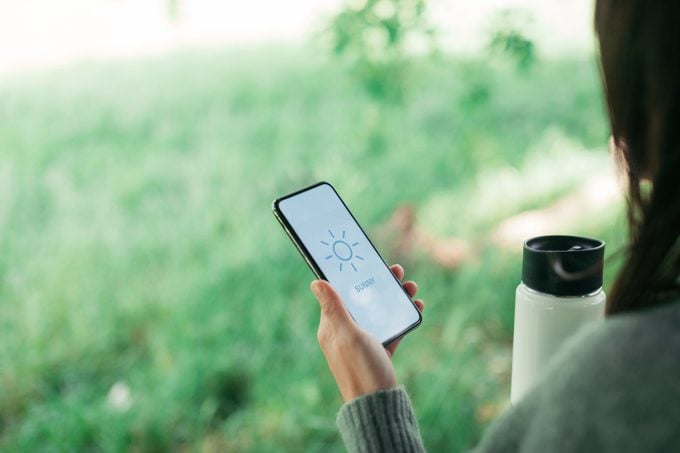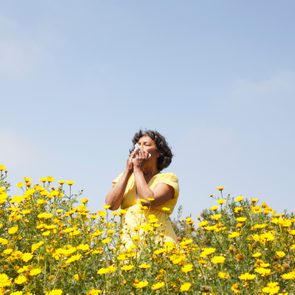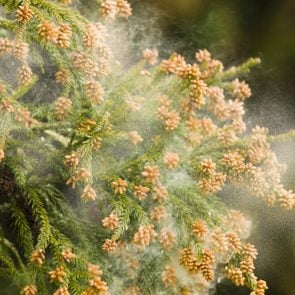What Is the Pollen Count? 3 Best Ways to Check
Updated: Mar. 08, 2022
The pollen count can help you better cope with allergy symptoms both indoors and outdoors. Learn how to check the pollen count daily.
What is the pollen count?
Pollen counts measure the number of grains of pollen in the air.
OK, but what’s the big deal? After all, it’s pretty obvious when the pollen counts are high. The yellowish-green stuff is all over cars and patio furniture.
Problem is, there’s pollen in the air even when your black car isn’t wearing a dusty yellow coat.
Pollen is actually microscopic, but if you get a ton of it together, you can see it. Sort of like how dust is hard to see—except the household dust bunnies congregating under your bed.
The pollen counts we see on weather reports include the pollen you see as well as the stuff you can’t see. And those barely visible particles can wreak big-time havoc for people allergic to pollen and those with asthma.

What is pollen?
The pollen primarily responsible for runny and stuffy noses, sneezing, and watery eyes that come from anemophilous (wind-pollinated) plants, trees, grasses, and weeds.
Pollen is a fine powder made of pollen grains that fertilize other plants of the same species via the wind. Even if you don’t have anemophilous-type plants in your backyard, you can still be affected. It can make its way from your neighbor’s yard, another city, or even another state.
The pollen from entomophilous plants (the bright and showy flowers we love) is carried by insects such as bees and usually doesn’t cause as many issues for people with allergies.
What plants cause pollen allergies?
The plants, trees, and weeds that have the potential to sabotage an otherwise glorious day are too many to list here, but some well-known culprits affect many people.
Ragweed is a primary source, namely the tall goldenrod and tooth-leaved variety that lives low in the grass.
Pollen from birch, cedar, oak, elm, box elders, and olive trees are common culprits. And Kentucky bluegrass, Johnson grass, Bermuda grass, Timothy grass, redtop grass, and perennial rye can all set your allergies ablaze.
The only definitive way to know which pollen you are allergic to is by getting an allergy test. (More on this later.)
Why does pollen cause allergies?
It doesn’t matter where the pollen comes from—a tree in your backyard or weeds from down the street. If pollen is in the air and you breathe it in, it can result in a condition called allergic rhinitis, or hay fever.
The rhinitis part means “inflammation of the nose.” Inflammation ensues when your body thinks the pollen you breathe in is a foreign substance. It then releases histamines, which trigger those tiresome symptoms.
A runny or stuffy nose, sneezing, wheezing, and itchy or watery eyes are among the symptoms of allergies.
Scientists still haven’t pinpointed why our body reacts this way or why one person can be allergic to pollen while another person isn’t. But a family history of allergies or asthma could put you at a higher risk of developing allergies at any age.
When are pollen seasons the worst?
Except for winter, when the count is low, pollen is around way more often than we like, and it sure can make life miserable when you want to lay on the hammock or open the windows for fresh air.
After being cooped all winter, you look forward to the vibrant colors of spring and budding trees, but that’s also when tree pollen concentrations are highest.
In the summer, it’s showtime for weed and grass pollen, which layer the landscape wherever you like to hang out, whether it’s near the lake, on a hiking trail, or at your backyard barbecue.
Then just when you think you can take tissues off your shopping list and bask in the gorgeous colors of autumn, fall ragweed pollen starts blowing around and robs your joy.
Will moving help my pollen allergies?
The type of pollen that affects you often depends on where you live, says Tina Sindher, MD, an allergist at Stanford Health Care in San Jose, California.
For example, she grew up on the East Coast, where ragweed is a major source of environmental allergies.
“Now that I’m in California, ragweed isn’t really one of the most common ones,” she says. “Here, it’s the grass allergies that tend to knock people out.”
If your pollen allergies are so bad that you’re scrolling Zillow for an escape, hold off on calling your realtor. “The first year or two after moving, you might feel amazing because the pollen structure is a bit different,” says Dr. Sindher.
However, since there are so many pollen types, your body will probably find new allergens to react to in time.

Is the pollen count affected by weather?
Yes. Your local pollen count may vary depending on the weather, as pollen spreads more easily when it’s hot, dry, and windy.
Rainy days might bring you down, but at least weed and grass pollen counts will be lower. Trees, not so much.
A 2020 study published in Environmental Science & Technology Letters shows that a downpour decreases intact pollen concentrations, but it can also increase pollen fragments for as much as 11 hours after heavy rain.
What’s the local pollen count?
Allergists, commercial research firms, universities, and government agencies can answer that.
Actually, anyone can check pollen counts if they buy the equipment. The most common devices are the Burkard and Rotorod.
Pollen count is determined using these air-sampling devices, which collect particles from the air—usually from a rooftop. The particles land on a sticky device and are examined under a microscope.
“The pollen count is the number of pollen grains per cubic meter of air,” says Daniel Sullivan, MD, an otolaryngologist and surgeon specializing in allergies at the Health First Medical Group in Melbourne, Florida. “The scale runs from zero to 12, zero being no pollen present.”
The calculated amount is classified as low, moderate, or high.
Pollen can travel long distances, so the count is typically used for an entire city. How accurate the numbers are is questionable.
A 2020 study published in The Journal of Allergy and Clinical Immunology compared daily pollen counts from Rotorod and Burkard and found them highly inconsistent.
Still, Dr. Sullivan says, “It’s useful as a relative gauge.”
Do high pollen counts mean I’ll be miserable?
Not necessarily. If you Google “is pollen high today” and discover the pollen count is high, it doesn’t mean you have to spend the day inside or start popping antihistamines.
There are many types of pollens from trees, weeds, and grasses, so an overall high pollen count doesn’t necessarily indicate that the specific pollen you are sensitive to has an intense concentration.
On the other hand, if the overall pollen count is low, you could still have the sniffles if one of the allergens—say, pollen from oak trees—grows prolifically near your house.
The link between your symptoms and pollen can be complex.
Let’s say the pollen count is low but you have a mild allergy to a friend’s dog. The dog rolls around in a type of pollen that you are allergic to, and suddenly you get a full-blown allergy attack, complete with sneezing and wheezing, from pet dander and pollen.
How to find the daily pollen count
There’s certainly no shortage of pollen-count websites and apps. But with so many, how do you choose among them and make sense of the numbers?
If a website only offers a general pollen classification of “low, moderate, or high,” it’s not going to be a strong guide, Dr. Sullivan says.
“Some of the sites only list ragweed, for instance,” he says. “It’s a big allergen, but a lot of people aren’t allergic to ragweed, so the ragweed number has nothing to do with what’s going on with the trees, which are also a big source of allergens.”
His advice: get pollen numbers for your zip code. “Tree pollen is going to be very high in February in Florida and zero in New York in February,” he explains.
Specific details can be rather helpful as you prepare for the day ahead—but only if you know the specific allergens that affect you.
Here are three options to track pollen counts in your neck of the woods:
The National Allergy Bureau (NAB)
The NAB is the only pollen (and mold) counting network certified by the American Academy of Allergy, Asthma, and Immunology (AAAAI).
The NAB gathers pollen and mold levels from certified stations across the nation. Also included are the current top trees, grasses, weeds, and mold species. You can find counts for your geographic region at the AAAAI’s National Allergy Bureau.
They don’t have an app, but you can opt in for email alerts when any new pollen pops up or when counts change. Bonus: there are no ads and the service is free.
Pollen.com
You might choose to check in via Pollen.com or use the free Allergy Plus app for Android and iPhone.
Enter your zip code, and a wealth of information populates. Easily find out the current pollen counts, a five-day forecast, and the top allergens for the day.
There’s plenty of other features to geek out on, like the pollen allergy levels from the previous 30 days. You can also learn more about the native plants—what they look like and when they are peaking in your area.
Opt in for email alerts or track your allergies with the allergy diary.
The Weather Channel
Weather and allergies often go hand in hand. Rain might drown out some allergens temporarily, while a windy day can boost their spread.
You can access the online Allergy Tracker, which includes a general 15-day forecast, or use the Weather Channel’s app, which predicts allergy symptoms with a “very low,” “moderate,” or “very high” level.
A pollen breakdown displays a three-day outlook for tree pollen, grass pollen, and ragweed pollen. Individual plants, trees, and grass aren’t included. The service is free.
How to use pollen counts to manage symptoms
Allergies demand a proactive approach because once your body releases histamines, it’s all over.
Monitoring daily pollen counts and upcoming forecasts gives you a valuable tool for heading off symptoms.
Classic signs of pollen allergies, such as sneezing, a runny and stuffy nose, and watery and itchy eyes, are similar to symptoms of the common cold, Covid-19, and other illnesses.
You want to be sure you’re actually dealing with allergies before you try to treat your symptoms.
Monitoring the pollen count could help you decide if you should reach for allergy medicine or heat up chicken soup for your cold.
Maybe you live in a warmer climate and wake up sneezing and blowing your nose on a January morning. You might think it’s too early for pollen and assume you have a cold. Checking the pollen count can help you sort it out.
“We can have warm winters in Florida, and the pollen is actually quite bad by late January, so the pollen count is going to be helpful in this scenario,” explains Dr. Sullivan.
Of course, it’s important to recognize that pollen numbers come with many variables, depending on the severity of your symptoms, location to allergens, and overall health.
Where can I get an allergy test?
Before you can determine if pollen counts of certain allergens may be bothering you, you need to find out which allergens you’re allergic to.
You could do an at-home allergy test, but those usually involve a blood sample, which isn’t nearly as accurate as a skin prick test by an allergist.
The test is conducted by placing a tiny amount of allergen on your skin. Then the area is gently picked or scratched. If redness and swelling appear at the site, you’re allergic to that allergen.
The results of the tests aren’t likely going to reveal one significant allergen—say ragweed. Some patients have one or two prominent allergies responsible for most of their symptoms, while others have several milder allergies acting together
With the test results in hand, your allergist can make treatment recommendations and chances are, you’ll feel a lot better.
Pollen allergy treatments
Allergists agree, hands down, that the best way to avert the sniffles is to avoid pollen altogether. But unless you plan on moving to Antarctica, that’s probably not realistic for you.
Wearing a surgical mask can help while your outside. Once inside, leave your shoes by the door and hit the shower. Wash the pollen off your body and out of your hair.
It may be possible to settle and soothe mild symptoms with nonprescription allergy medicines and nasal sprays.
For more-severe cases, an allergist will likely prescribe medication, allergy shots, or sublingual tablets after an allergy test reveals the allergens affecting you.
Common ways to fend off or treat symptoms that are already raging include over-the-counter and prescription medicines. Here’s an example of some popular and effective treatments to keep allergy symptoms at bay:
- Saline nasal wash
- Nasal antihistamine spray
- Nasal corticosteroid spray
- Antihistamine pills
- Decongestants
The good news is that allergies are manageable. But if you’re struggling to get yours under control, don’t hesitate to speak with an allergist, who can help you come up with a treatment plan that works.




















